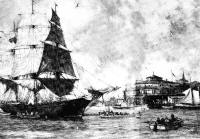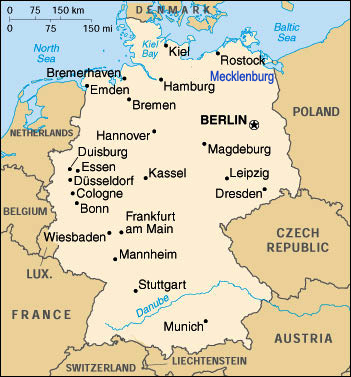|
 Hamburg became a port of emigration because of its
competition with Bremen as a seaport for trade. In the early
1830s, Bremen was doing well in its trade with America, while
Hamburg's trade was mostly with the West Indies and Latin America.
When a ship arriving from America was ready for the return trip,
Bremen often did not have enough export goods and the ship had
to return to America empty. This made the shipping process very
expensive. Hamburg became a port of emigration because of its
competition with Bremen as a seaport for trade. In the early
1830s, Bremen was doing well in its trade with America, while
Hamburg's trade was mostly with the West Indies and Latin America.
When a ship arriving from America was ready for the return trip,
Bremen often did not have enough export goods and the ship had
to return to America empty. This made the shipping process very
expensive.
To combat this problem, Bremen began to lure part of
the emigration traffic away from other European ports such as Le
Havre, Antwerp, and Rotterdam. Its efforts were successful.
Meanwhile, Hamburg had a decree which forbid group emigration an
allowed only single
families or travelers to emigrate from their port.
 The collection of
large numbers of emigrants in Bremen caused some problems. Often emigrants were stranded without food and
had to go begging because for
enough money for lodging or passage. Unscrupulous ship's agents
enticed them to Bremen and then took what money the
emigrants had without providing passage. The collection of
large numbers of emigrants in Bremen caused some problems. Often emigrants were stranded without food and
had to go begging because for
enough money for lodging or passage. Unscrupulous ship's agents
enticed them to Bremen and then took what money the
emigrants had without providing passage.
Bremen passed a
decree in 1832 which freed the city from giving financial
assistance to emigrants, while making it obligatory for
ship owners to certify the seaworthiness of their vessels, to
keep passenger lists, and to keep provisions for 90 days on
board. This meant that ship's agents had to deliver what they
promised.
In order to keep up with Bremen and reap some of the emigration
profits as well, Hamburg finally decided to open up group
emigration. The City Council published a decree in February of
1837 which laid out the space entitlement of each passenger, the
size of the bunks, and the quantity of provisions that were to
be taken on the voyage. Hamburg also established its first liner
service between Hamburg and New York to handle the emigration.
 Hamburg ships began advertising their crossings. Such an
advertisement might read, "The passengers from the day of
embarkation to the day of disembarkation at the port of
destination receive free board on the scale usual on seagoing
ships. This consists of sustaining and nutritious food such as
salt beef, salt pork, herrings, peas, beans, pearl barley, oats,
rice, sauerkraut, butter, plums,
pastries, pudding, etc., all in
sufficient quantity and of the best quality. Coffee is served in
the mornings, and in the evenings tea and ship's bread with
butter. In accordance with the decree of the local authority,
the ships are provisioned for 90 days so that the passengers
will not lack for anything on the longest voyage."
Hamburg was not a good city for emigrants, however, and there
were no regulations about their treatment during their stay in
the city. Most emigrants arrived in Hamburg by rail. Every
landlord tried to entice as many emigrants as he could to his
inn or lodging house. The emigrants, who were naturally
not familiar with Hamburg conditions, were frequently the
victims of fraud. They were charged very high prices for board
and lodging or were sold unneeded utensils for the voyage. Many
lost much of their money before they even left Europe.
In order to stop the "runner's racket",
the Association for the Protection of Emigrants, was founded in
Hamburg in 1850. From that date forward, on their arrival at the
railroad station, most emigrants received information on the
average price of board and accommodation, how to transfer
baggage, the necessary utensils for the voyage, the current
rates of exchange, and the different types of passage available
to America.
 However, by the year 1854, the emigrants leaving
Hamburg rose to nearly 51,000, and the private association could
no longer handle the numbers. Finally, in 1855, the City of
Hamburg took over the Information Office and its staff. At the
same time, the Emigration Office was given the judicial
authority to quickly settle disputes between emigrants and
landlords or businessmen before the emigrant sailed. This gave
another protection to the emigrants that they did not have
previously. |